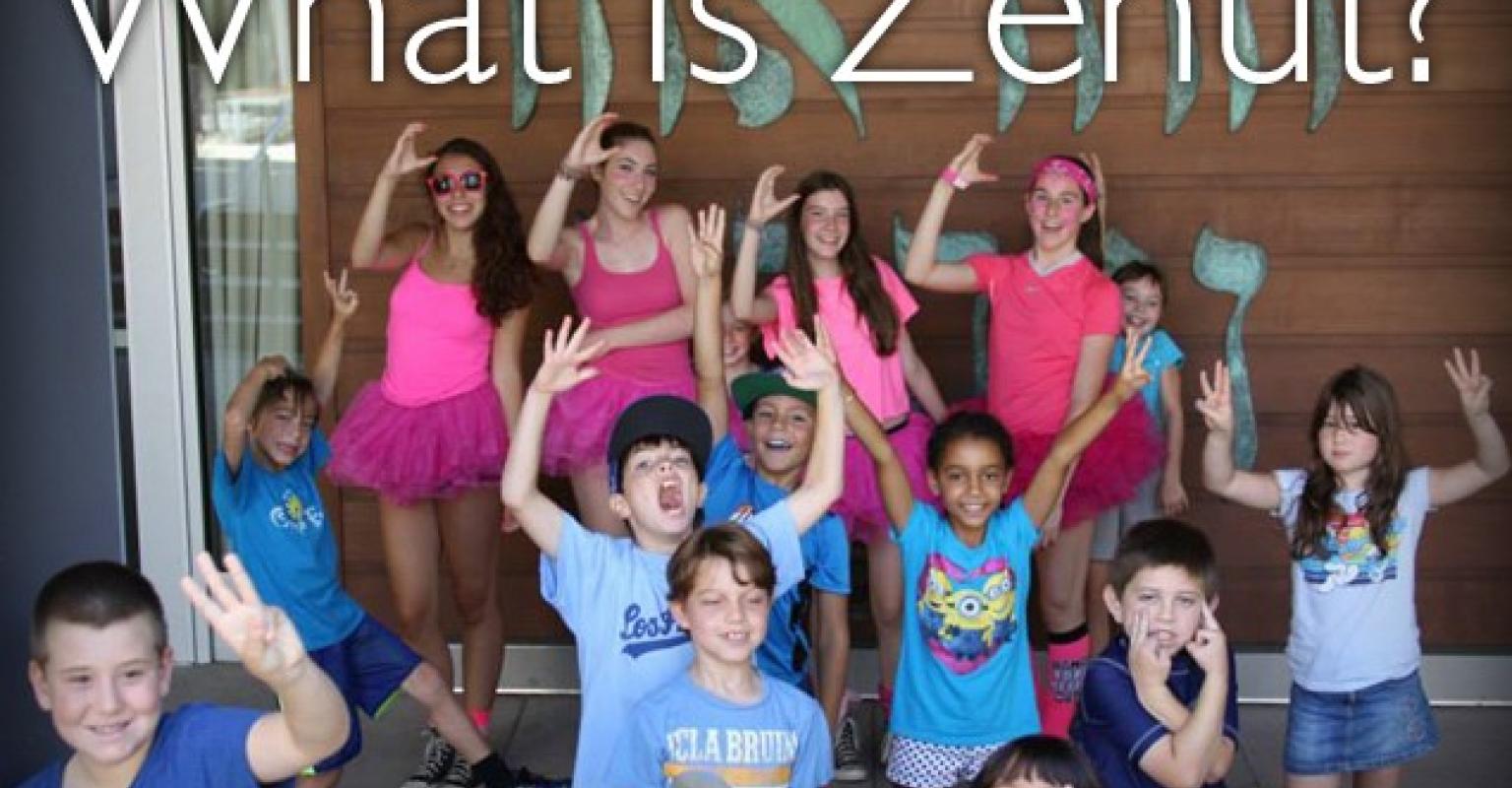Shabbat Centered Model: Gesher
Peninsula Temple Beth El (PTBE), San Mateo, CA
Model description adapted from The Express Innovation Guidebook, 2011 with update at end from 2017.
What Were You Trying to Achieve with this Model?
-
Enable families to connect to one another and the congregation more deeply
-
Experience worship embedded within the larger context of Jewish learning
-
Learning no longer limited by available classroom space or setting
-
Families experiencing Shabbat in real time
-
Multiple learning experiences to meet varied needs of learners
- Gesher met the desire of a small but vocal group of parents who were looking for more engagement for themselves, more family connections, and stronger connections to the congregational community. Also, a growing student population meant that the congregation would need to move to double sessions of Sunday School in order to find space for all learners. When faced with the choice of replicating the existing model or creating an alternative model, the congregation chose to launch an alternative model.
Relationship of Model to Congregational Learning System:
-
Major holiday celebrations are congregation-wide.
-
All congregational families are able to participate in the K-6 Family Shabbaton Retreat.
-
Children in grades 4-6 still come for mid-week Hebrew.
- Social events are offered for specific age groups outside of Gesher.
Who are the Learners?
-
Children in grades K-6 and their families.
-
A self-selecting group.
-
Initially the congregation hoped to have twenty families participate in Gesher. Fifty-five families participated in the first year, some of them joining the congregation expressly to be a part of this program.
-
Next year the number is projected to be 60-65 families.
- Families with children in day school also participated, a first for the congregation.
Who are the Educators/Learning Facilitators?
-
Members of clergy work with parents.
-
Teachers had a combination of experience with classroom, informal, and experiential learning.
- PTBE was able to hire some teachers with significant Jewish background because of Shabbat vs. mid-week plus Sunday morning commitment.
What is the Learning? How is it Designed?
-
A combination of family study, adult and child parallel learning.
-
The worship component varies depending on the time of day that the class meets, but it includes Kabbalat Shabbat, Shabbat morning and Havdalah.
-
Learning also involves a combination of formal study and action.
-
Content is organized thematically so that all age groups are learning about the same theme on age-appropriate levels.
-
5th and 6th grade junior book club will be launching in the coming year.
- During Shabbat Day Family Study and Worship Experiences, families meet in small groups with similar age kids. Families begin together, move into separate groups for parallel study of parashat hashavua – adults with clergy and kids with teachers – and then come back together for sharing or a family activity followed by participation in Shabbat worship. Next year the parallel study will focus on Middot (values) with study of Torah woven in as well.
Where Does the Learning Happen?
-
All Shabbat meetings take place at the synagogue except two times a year when families participate in Shabbat BaBayit, Shabbat dinner in one another’s homes.
-
Families meet in various synagogue spaces including classrooms and the sanctuary.
-
Sunday afternoon learning occurs outside of the synagogue.
-
Initially, the third learning experience of the month was scheduled for Sunday afternoons with half an hour overlap between regular Sunday School and Gesher programs. However, families preferred the opportunity to come together on Shabbat. As a result the third learning opportunity each month is scheduled for Shabbat afternoon.
-
Moving learning outside of the exclusively classroom setting proved a key component to the alternative program. While initial Sunday afternoon learning took place at the synagogue, next year some will take place off-site in response to parent feedback.
When Does the Learning Happen?
-
Gesher meets on the first Shabbat evening, second Shabbat morning, and third Shabbat afternoon each month. Friday night services run from 6:30-7:30 pm. Families attend Shabbat dinner before services at 5:30 pm or following services at 7:30 pm. Shabbat Day Family Study and Worship Experience meets from 9:15 am – 12 pm and from 3:45-6:00 pm in the afternoon on the second and third Saturday’s in the month respectively.
-
There are four additional Sunday afternoons each year involving family learning or off-site excursions.
-
The program begins with a mini-shabbaton in the fall.
-
4th-6th grade students attend mid-week Hebrew class.
-
In the spring, families attend the Family Shabbaton Retreat which is also open to learners in the regular Sunday School program.
- With a clear calendar in hand well in advance, parents enjoy the flexibility of the schedule and the varying times and days holds kids interest as well. The new approach to scheduling enabled the educator to hire teachers with richer Jewish backgrounds who didn’t have the time to commit to a twice weekly model.
What is Inspiring about this Model?
-
Gesher parents are increasingly involved in synagogue leadership.
-
Adults are rediscovering Judaism as a result of being at synagogue with their families.
-
Kids are more engaged in their learning.
-
There is increased attendance at Shabbat worship services.
-
Gesher has created a positive buzz in the larger community about the congregation.
- Some new families joined the congregation in order to participate in Gesher.
Professional Learning:
The Director of Education for K-6 provided training sessions for those teachers who would be working with entire families together in addition to children.
Key First Steps and Recruitment Plan:
-
The Education Committee met for two years to research and develop Gesher.
-
Before launching, the Director of Education for K-6 held two community conversations during regular Sunday School for parents to find out about the alternative program.
-
Education Committee members attended the community conversations in order to provide the lay and parent perspectives.
-
The model was also presented to the Board of Trustees as part of the implementation process.
-
A Gesher brochure was created and was distributed once community became familiar with the program.
- The community conversations were a critical first step towards launching the alternative model. They provided an opportunity for an in-person introduction and explanation which could then be followed by a detailed brochure.
Role of Governance and Clergy:
-
The Education Committee and Rabbi/Educator were initially responsible for the creation of Gesher.
-
Currently the Gesher Focus Group, made up of some members of the Education Committee and several Gesher parents, meets with the Director of K-6 education to provide feedback and guidance.
- The Gesher Focus Group created a survey that went to all Gesher parents. The results of the survey led to the move to Shabbat afternoon meetings each month instead of Sundays and to the adoption of a theme based vs. grade based curriculum for Gesher.
Budget:
-
In the first year, the congregation received a Legacy Heritage Innovation Grant.
-
Without the grant, PTBE will need to charge Gesher Families more than they charge those in the regular Sunday School program.
-
Childcare for younger siblings is provided for a fee.
-
Need to budget for a separate Gesher brochure.
-
Additional staffing is required to implement program.
-
There are additional costs for meals and materials.
- Grant money in the first year enabled the congregation to charge Gesher families the same amount as those participating in the regular Sunday School program. In the coming year, some costs covered by the grant will need to be passed on to the families.
How Do You Describe Your Congregation?
PTBE is a large Reform congregation, approximately 810 family units. They have a senior rabbi, a cantor, 3 rabbi/educators, an early childhood director, and Senior Youth Group Advisor/Director.
Update (July 2017)
 Current Status:
Current Status:
Gesher continues to engage learners and their families at Peninsula Temple Beth El (PTBE). It will, however, undergo significant change this summer. Gesher began as an alternative model in 2010 for learners in K-6 and their families, as parents had expressed dissatisfaction with the traditional religious school and a desire for deeper learning.
When Gesher began, about 20 families participated; by 2013, the number of families had grown to 60. In 2013, the current educator was hired to oversee family education, and a second rabbi joined PTBE to oversee its religious school. Under the leadership of the educator and rabbi, the religious school model underwent significant change; since then people have been happy with the religious school. At the same time, it became unwieldy to have 60 families in Gesher.
In addition to Gesher and the traditional religious school, there was a third educational model, Tiyul, for 5th and 6th graders and their families. Tiyul was designed in response to families who were unhappy with the traditional model but who nevertheless did not show up for Gesher family experiences. While Tiyul supported family engagement, it was not a family program and was not designed to be a learning experience for parents. It included at home experiences, field trips, and informal learning at the temple. Parents did not have to come to the congregation but were naturally involved since some of the learning took place at home. Gesher changed from a K-6 model to one that focused on families with younger children in K-4.
PTBE is currently adapting Gesher and Tiyul to provide an alternative learning experience that works for families across the elementary age range. As a result, Gesher will be absorbing Tiyul this fall. In this new combined model, Gesher l’Kesher, the learning for learners in K-3 will continue as a family model and will still be referred to as Gesher. Learners in grades 4-5 will be part of Kesher. Kesher will follow the Tiyul structure and include only the learners, not their families.
The educators are working hard at listening for what families want. Through listening and observing, they learned that it was hard for people to come in the middle of the day on Shabbat. In response, they changed Gesher so that family experiences are no longer held on Shabbat afternoons.
For the 2017-18 year, 25 families are expected to participate in Gesher (K-3), and 25 4th and 5th graders in Kesher.
 Reflections of the Educator:
Reflections of the Educator:
The educator, who directs family education at PTBE, attributes the success of Gesher to a variety of factors. She notes that she and the religious school director work as a team: they speak the same language and have a great working relationship. In addition, PTBE has an involved education committee that is very intentional in planning and developing the learning at PTBE. They are intentional as they plan and develop the learning at PTBE. The educator shares that she feels fortunate to be in a community that is open to experimenting with new approaches and doesn’t regard changing and trying new things as failure.
Building relationships in the community is a large goal of Gesher. PTBE is proud that the families who participated regularly in Gesher have become closely connected with one another. These authentic relationships are evident in their daily lives. For example, people who have met through Gesher have seders together: a group of women came together for a women’s seder, and some families have invited others to their family seders. In addition, many Gesher families now carpool with one another. The educator also tells the story of two families who had never met before and were matched up at a Shabbat Babayit, a structured pot-luck Shabbat dinner; these families now go out to dinner together on their own. The educator is also mindful of the downside: that families who are only peripherally connected with Gesher sometimes feel that Gesher is cliquish.
Moments, when a parent’s learning is clicking, are very rewarding to the educator. She sees how this learning opens up important conversations and helps a parent with their own Jewish learning.
Building upon the success of the adaptations and innovations made to Gesher, PTBE has also tested out and is now offering pre-Gesher experiences for families with very young children. While the present educator was not the one who began Gesher, she shares that it was very important to have a group of stakeholders on board prior to setting the model into motion. She underscores the invaluable role played by supportive connectors and advises that a congregation cannot rely on only one person to do this important work alone.
The educator reflects that her big “take away” is that Jewish learning is a moving target and that we always need to adapt.
- Models-In-Action
- Shabbat
- Intergenerational Learning
- After School and Beyond
- Congregational Learning
- Teen Engagement
- Educator Training
Discover more

Shabbat Centered Models focus on coming together within the context of Shabbat to worship, study, and connect to one another.

Temple Judea, Tarzana, CA. Nisayon includes week-long camp experiences, family programming, and parallel adult education. Annual content themes are paired with activities like music, dance, drama, and krav maga.

An interactive table to support selecting an innovation model for congregational learning.
